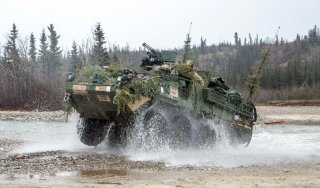Get Ready, Russia: Could A New Vehicle Clinch The U.S. Army's Arctic Strategy?
Increased activity in the Arctic, accelerated by fast-melting ice, continues to generate substantial international competition, particularly between Russia and America.
Here's What You Need To Remember: Having an Arctic-ruggedized combat vehicle certainly introduces a number of tactical advantages. Not only can it transport forces across dangerous, sub-zero terrain, but could perhaps at some point be configured as an unmanned variant designed to transport supplies, ammunition, fuel and other essential resources at minimal risk to soldiers.
Combat in the Arctic is a difficult proposition.
Sub-zero temperatures, penguins, polar bears, ice, glaciers and snowstorms all present challenges for possible combat operations. This is a growing concern among U.S. weapons developers now that the military is massively increasing Arctic warfare preparations.
Increased activity in the Arctic, accelerated by fast-melting ice, continues to generate substantial international competition, particularly between Russia and America. Arctic ice is melting much faster than previously anticipated, leading major powers to see a fast-pressing need to step-up Arctic war preparation more than ten-years earlier than expected. Warmer weather and higher water temperatures are melting ice, opening up new waterways, areas for transit and an ability to gather resources and strategic advantages. Russia’s Northern Sea Route along the country’s Arctic border presents the largest and most prominent waterways approaching the Arctic. In order to protect that area and its resource claims, Russia has more ice breakers than the United States, and Moscow has been massively increasing its Arctic operational-tempo and basing there.
For all of these reasons, the Office of Naval Research is looking at ways to help advanced weapons systems operate in extreme temperatures. The Pentagon is fast-tracking new icebreakers. The Army’s cold weather units, such as the 10th Mountain Division and Alaska-based forces are increasing the volume and frequency of cold weather warfare preparations. As part of this, the Army is also moving quickly to acquire a new Cold Weather All Terrain Vehicle, a platform especially engineered to operate in the harshest of cold weather combat conditions.
The CATV Request for Prototypes Proposals was issued by the Army in June through the National Advanced Mobility Consortium, a BAE Systems statement said. Early prototypes will eventually be submitted for “limited performance and endurance testing,” according to the Army’s request for proposal.
BAE Systems is one vendor moving to offer a solution with its “Beowulf” vehicle. BAE reports that Beowulf is based on the BvS10, which is currently in production and already operational in multiple variants with five countries, first going into service with the U.K. Royal Marines in 2005.
“The Beowulf and its armored sister vehicle, the BvS10, represent the most advanced vehicles in the world when it comes to operating in any terrain, whether it’s snow, ice, rock, sand, mud, swamp, or steep mountainous climbs, and its amphibious capability allows it to swim in flooded areas or in coastal water environments,” Keith Klemmer, director of business development at BAE Systems, said in a written statement.
Having an Arctic-ruggedized combat vehicle certainly introduces a number of tactical advantages. Not only can it transport forces across dangerous, sub-zero terrain, but could perhaps at some point be configured as an unmanned variant designed to transport supplies, ammunition, fuel and other essential resources at minimal risk to soldiers. Also, should there need to be an Arctic attack or advance of some kind, it goes without saying that an Arctic-ready vehicle could greatly change the equation by advancing attacking infantry or even pulling weapons systems such as artillery. It could incorporate sensors intended to assess the thickness or strength of ice as well.
Of course, BAE has not discussed any specifics related to its offering, yet the existence of such a platform raises interesting questions about the kinds of systems and technologies likely to inform its construction. BAE’s Beowulf offering looks like a tracked vehicle which most likely incorporates newer kinds of warming and propulsion technologies, as well as cold-weather operational hardening of various kinds. Interestingly, it would also make sense if, as a tracked vehicle, the Beowulf were able to climb glaciers and descend at safe speeds without sliding.
Also, it would not be surprising if Beowulf’s technical systems incorporate some kinds of hull-warming, ice-melting technologies now being fast-tracked for Navy ships preparing for Arctic operations.
Finally, it would also seem likely that this kind of ice-ready vehicle includes some kinds of systems engineered to prevent an engine or vehicle oils from freezing.
Kris Osborn is the defense editor for the National Interest. Osborn previously served at the Pentagon as a Highly Qualified Expert with the Office of the Assistant Secretary of the Army—Acquisition, Logistics & Technology. Osborn has also worked as an anchor and on-air military specialist at national TV networks. He has appeared as a guest military expert on Fox News, MSNBC, The Military Channel, and The History Channel. He also has a Masters Degree in Comparative Literature from Columbia University. This article first appeared earlier this year.
Image: Flickr.

